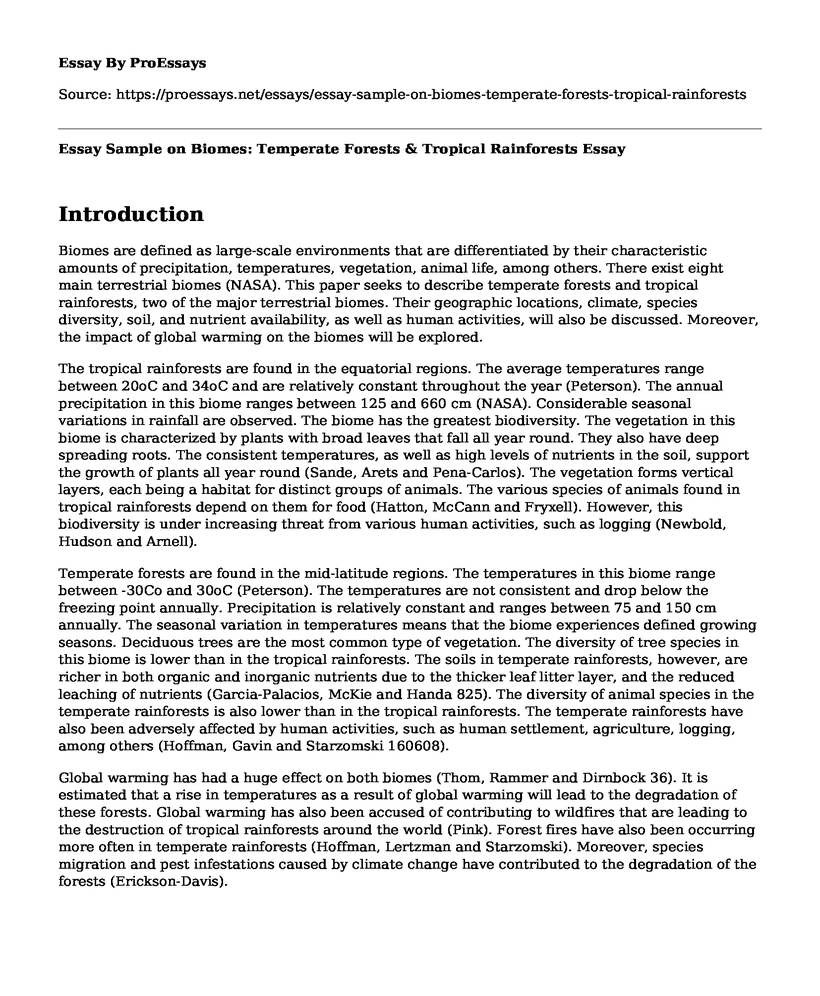Introduction
Biomes are defined as large-scale environments that are differentiated by their characteristic amounts of precipitation, temperatures, vegetation, animal life, among others. There exist eight main terrestrial biomes (NASA). This paper seeks to describe temperate forests and tropical rainforests, two of the major terrestrial biomes. Their geographic locations, climate, species diversity, soil, and nutrient availability, as well as human activities, will also be discussed. Moreover, the impact of global warming on the biomes will be explored.
The tropical rainforests are found in the equatorial regions. The average temperatures range between 20oC and 34oC and are relatively constant throughout the year (Peterson). The annual precipitation in this biome ranges between 125 and 660 cm (NASA). Considerable seasonal variations in rainfall are observed. The biome has the greatest biodiversity. The vegetation in this biome is characterized by plants with broad leaves that fall all year round. They also have deep spreading roots. The consistent temperatures, as well as high levels of nutrients in the soil, support the growth of plants all year round (Sande, Arets and Pena-Carlos). The vegetation forms vertical layers, each being a habitat for distinct groups of animals. The various species of animals found in tropical rainforests depend on them for food (Hatton, McCann and Fryxell). However, this biodiversity is under increasing threat from various human activities, such as logging (Newbold, Hudson and Arnell).
Temperate forests are found in the mid-latitude regions. The temperatures in this biome range between -30Co and 30oC (Peterson). The temperatures are not consistent and drop below the freezing point annually. Precipitation is relatively constant and ranges between 75 and 150 cm annually. The seasonal variation in temperatures means that the biome experiences defined growing seasons. Deciduous trees are the most common type of vegetation. The diversity of tree species in this biome is lower than in the tropical rainforests. The soils in temperate rainforests, however, are richer in both organic and inorganic nutrients due to the thicker leaf litter layer, and the reduced leaching of nutrients (Garcia-Palacios, McKie and Handa 825). The diversity of animal species in the temperate rainforests is also lower than in the tropical rainforests. The temperate rainforests have also been adversely affected by human activities, such as human settlement, agriculture, logging, among others (Hoffman, Gavin and Starzomski 160608).
Global warming has had a huge effect on both biomes (Thom, Rammer and Dirnbock 36). It is estimated that a rise in temperatures as a result of global warming will lead to the degradation of these forests. Global warming has also been accused of contributing to wildfires that are leading to the destruction of tropical rainforests around the world (Pink). Forest fires have also been occurring more often in temperate rainforests (Hoffman, Lertzman and Starzomski). Moreover, species migration and pest infestations caused by climate change have contributed to the degradation of the forests (Erickson-Davis).
Conclusion
This paper has shown that the two biomes are under an increasing threat from human activities. Moreover, climate change is bringing about a degradation of the forests at unprecedented rates. Therefore, there is a need for concerted efforts to address the issue.
Works Cited
Erickson-Davis, Morgan. "Scientists warn of global warming threat to temperate rainforests." 13 March 2015. Mongabay. 15 December 2019.
Garcia-Palacios, Pablo, et al. "The importance of litter traits and decomposers for litter decomposition: a comparison of aquatic and terrestrial ecosystems within and across biomes." Functional Ecology 30.5 (2016): 819-829.
Hatton, Ian A., et al. "The predator-prey power law: Biomass scaling across terrestrial and aquatic biomes." Science 349.6252 (2015): aac6284.
Hoffman, K. K., K. P. Lertzman and B. M. Starzomski. "Ecological legacies of Indigenous fire management in high-latitude coastal temperate rainforests, Canada." AGU Fall Meeting Abstracts (2016).
Hoffman, Kira M., Daniel G. Gavin and Brian M. Starzomski. "Seven hundred years of human-driven and climate-influenced fire activity in a British Columbia coastal temperate rainforest." Royal Society open science 3.10 (2016): 160608.
NASA. "Rainforest." 2019. NASA. 15 December 2019.
Newbold, Tim, et al. "Has land use pushed terrestrial biodiversity beyond the planetary boundary? A global assessment." Science 353.6296 (2016): 288-291.
Peterson, John. "Rainforest Weather & Climate." 19 April 2018. Sciencing. 15 December 2019.
Pink, Jessica. "3 ways climate change affects tropical rainforests." 26 June 2018. Conversation International. 15 December 2019.
Sande, Masha T. van der, et al. "Soil fertility and species traits, but not diversity, drive productivity and biomass stocks in a Guyanese tropical rainfores." Functional ecology 32.2 (2018): 461-474.
Thom, Dominik, et al. "The impacts of climate change and disturbance on spatiotemporal trajectories of biodiversity in a temperate forest landscape." Journal of Applied Ecology 54.1 (2017): 28-38.
Cite this page
Essay Sample on Biomes: Temperate Forests & Tropical Rainforests. (2023, Mar 20). Retrieved from https://proessays.net/essays/essay-sample-on-biomes-temperate-forests-tropical-rainforests
If you are the original author of this essay and no longer wish to have it published on the ProEssays website, please click below to request its removal:
- Questions and Answers About Animals
- Compare and Contrast Essay on ALF and PETA
- Testing on Human Vs Testing on Animals Essay Example
- Essay Sample on Mountain Formation: Orogeny, Volcanism & Tectonics
- IEEE EMBS: A Global Biomedical Engineering Society - Research Paper
- Essay Example on Tragic Death of Tiger Keeper Raises Questions on Captive Wildlife Space
- Report Example on Management of Stormwater







